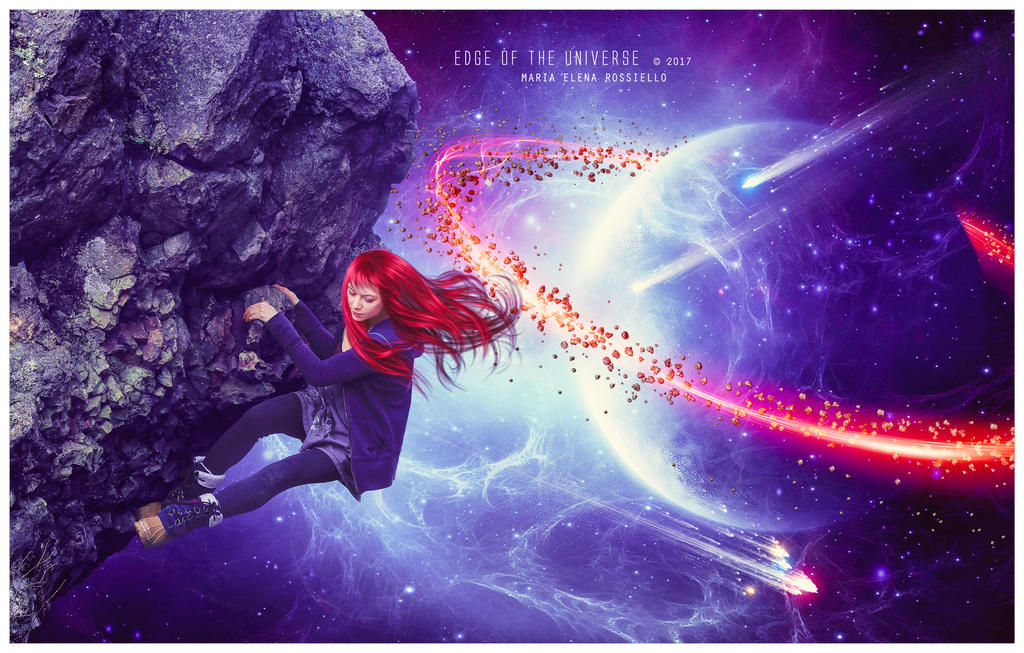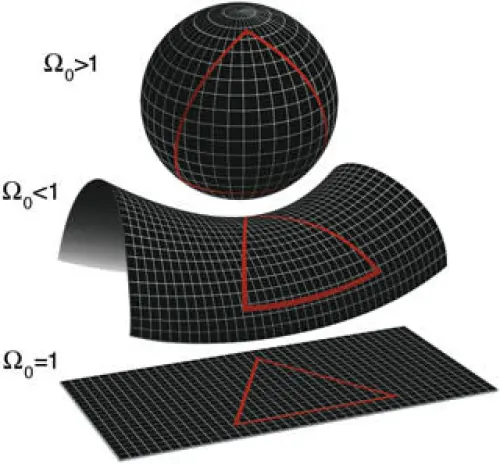Written by JM Strasser

An old concept just popped up for me. Is there an end to the Universe? I don’t necessarily mean the end of time, but that is tied up in this idea. Is there an end, a wall, or a cliff? Or does it go on forever? By definition, the Universe is everything, so having a wall (for an end) would be part of that, but the other side would, too. This is an old nightmare idea for me. It’s creepy to think of the Universe going on forever, and for some reason, it is more comforting to believe there is a wall. I think of that wall, then immediately think of what is on the other side: a place to explore. I realize that is silly because that means it does not end at the wall. I guess human beings like the idea of defined borders.
The basics of this discussion could be broken down into four elements. The shape, age, movement, and composition of the Universe. Though the subject matter is vast, there isn’t much to prove or explore in these areas. However, that doesn’t stop scientists and us lay people from postulating and even declaring. Humans certainly have hubris.

So, first, there are three possible shapes to the Universe: a sphere or positive curvature, a saddle or negative curvature, and flat or no curvature. Few scientists like the saddle shape, but the sphere is widely favored. Maybe because it is the shape of our world. The flat Universe held a certain charm, like the popularity of the flat earth theory. It seems logical because that is how the world appeared until we went into space and looked back at Earth. The shape of the Earth had been discovered before that, but people often believe what they see.
Could you see ‘beyond’ the Universe, like looking over a cliff edge or out a window? Robert McNees, an associate professor of physics at Loyola University Chicago, says, “Probably not.” 6 One reason is the “cosmological principle.” The cosmological principle states that the distribution of matter in any part of the Universe looks roughly the same as in any other part, regardless of what direction you look in; in scientists’ terms, the Universe is isotropic. I don’t think that covers the concept because if the Universe ended, it wouldn’t be isotropic outside of itself. It would be nothing, or would it?
Further explanation of the sphere idea, explores what an ant (lovely, we’re ants) walking around on a balloon would see. Well, yes, the curve of a sphere would cause a creature walking along the outside to eventually return to where they started. That still doesn’t explain what is outside the sphere, only that we can’t ‘look.’
This cosmological principle, isotropic, is, in part, the idea that the laws of physics are the same everywhere. “There’s lots of local variation — stars, galaxies, clusters, etc. — but averaged over big chunks of space, no place is really that different than anywhere else,” Mr. McNees told Live Science in an email.6 So, if there is no “edge,” there is no place to look in some direction and see what’s beyond it.
Secondly, the concept of age, how long has the Universe been around. Our favorite pet theory is “The Big Bang”. An initial hot, small, and dense superforce exploded 13.8 billion years ago and continues expanding. Some scientists have agreed that the Big Bang theory matches their observations.14 The theory itself was originally formalized by George Lemaitre in 1927. Hubble’s law of the expansion of the universe provided foundational support for the theory.18

That leads to the movement of the Universe. Hubble’s law states that all objects observed in deep space have a Doppler shift-measured velocity relative to Earth, and to each other. That velocity is proportional to their distance from the Earth and all other interstellar bodies. The space-time volume of the observable universe is expanding. Hubble’s law is the direct physical observation of this.18
However, scientists then thought it might be a “Big Bounce.” It was initially suggested as a phase of the cyclic model or oscillatory universe interpretation of the Big Bang, where the first cosmological event resulted from a previous universe’s collapse.16 Unfortunately, there has not been a way to test these theories, and some of our theories, like quantum physics, contain nothing about triggering the expansion.
Now we have the physical cosmology, cosmic inflation, cosmological inflation, or just inflation, that is a theory of exponential expansion of space in the early universe. The inflationary epoch is believed to have lasted from 10−36 seconds to between 10−33 and 10−32 seconds after the Big Bang. (It boggles the mind how that was determined.) Following the inflationary period, the universe continued to expand, but at a slower rate. The acceleration of this expansion due to dark energy began after the universe was already over 7.7 billion years old (5.4 billion years ago). Dark energy is a hypothetical form of energy that permeates all space and tends to cause the Universe to expand by exerting a gravitational repulsion, countering ordinary gravitational attraction.17
Paul Steinhardt, one of the original architects of inflationary theory, became fed up with the lack of predictiveness and untestability. “Do we really need to imagine an infinite number of messy universes that we have never seen and never will see to explain the one simple and remarkably smooth Universe we actually observe?” he asks. “I say no. We have to look for a better idea.” “The theory is completely indecisive,” says Steinhardt. “It can only be said that the observable Universe might be like this or that or any other possibility you can imagine, depending on where we happen to be in the multiverse. Nothing is ruled out that is physically conceivable.”17 I believe he, in part, is referring to the addition of dark energy, another theoretical component theorized to ‘answer’ questions that can’t be proven to exist.
Now we have the “Big Rip”. This theory shows that matter is progressively torn apart by the expansion of the Universe at a particular time in the future. The Hubble constant increases to infinity in a finite time. The idea relies on a type of dark energy present in our Universe. This can provide one of the possible explanations for the Universe’s current accelerating expansion rate. In this idea, if dark energy increases without limit, it could overcome all forces that hold the Universe together. Another theory with issues and difficult to impossible to prove.2
A new wrinkle has been proposed that the laws of physics are not uniform. A team of astrophysicists based in Australia and England has uncovered evidence that the laws of physics are different in different parts of the Universe. This comes from the fine-structure constant (alpha for short) that tells us the strength of electromagnetism is not the same everywhere. The team has reported this fine-structure constant varies by only a tiny amount—about one part in 100,000—over most of the observable Universe. Still, more significant variations could occur beyond our visual horizon. Thus, the laws of physics may not be the same everywhere.8
However, it is definitely not proven. “Despite some tantalizing hints, the latest studies all show that changes to the fine structure constant are “consistent with zero. That doesn’t mean that the fine structure constant absolutely isn’t changing. But if it is, it’s doing so more subtly than these experiments can detect, which seems unlikely. It’s hard to squeeze a theory into the little daylight between not changing at all and not changing enough to see it.” Sean Caroll, a theoretical physicist at Caltech.9. I would argue nutrition labels do this (proclaim zero grams when below a certain weight.) That is cynical but perhaps true.
Neil Turok has also explored another avenue for a simpler alternative to inflationary theory, the “Mirror Universe.” It predicts that another universe dominated by antimatter but governed by the same physical laws as our own is expanding outwards on the other side of the Big Bang – a kind of “anti-universe” if you like. “I take one thing away from the observations of the last 30 years, which is that the Universe is unbelievably simple. At large scales, it is not chaotic. It is not random. It’s incredibly ordered and regular and requires very few numbers to describe everything.”7 This step to a more streamlined theory could lead to something provable.
In conclusion- what do humans know? We feel pretty sure that the Universe is expanding. We know the Universe is bigger than we can detect on Earth. That is because of telescopes, probes, and the astronauts outside our atmosphere. The view changes, and different aspects of space are seen. A broad range of data is being discovered about the nature of space and objects (like planets) in space. We possibly know that universal physical laws could be changing. That is a lot, and much more is coming, but it doesn’t answer the main question -Is there an end to the Universe?
It seems to me the bottom line is that scientists feel ‘it must be true that the Universes has no end’ because we can’t think of what else it could be? Hell of a way to think in science. Only the facts, please.
“As we develop new theories and new models of cosmology, those will give us other interesting predictions that can that we can look for. The hope is not necessarily that we’re going to see the beginning more directly but that maybe, through some roundabout way, we’ll better understand the structure of physics itself. Until then, the story of our Universe, its beginnings, and whether it has an end will continue to be debated.” Katie Mack is a theoretical cosmologist who holds the Hawking Chair in Cosmology and Science Communication at Perimeter Institute.7
Well said.
I am not a cosmologist, just someone who loves the study of the Universe and can follow many of the arguments.
©JM Strasser October 16, 2023 All Rights Reserved
Sources
1. https://www.astronomy.com/science/where-is-the-edge-of-the-universe/ 2023
2. https://en.wikipedia.org/wiki/Big_Rip no date (Wikipedia)
3. https://en.wikipedia.org/wiki/Hubble%27s_law no date (Wikipedia)
4. https://www.science.org.au/curious/space-time/how-do-astronomers-know-universe-expanding 2017
5. https://www.livescience.com/49958-theory-no-big-bang.html 2015
6. https://www.livescience.com/33646-universe-edge.html 2016
7. https://www.worldatlas.com/articles/where-is-the-end-of-space.html 2020
8. https://www.sciencedaily.com/releases/2010/09/100909004112.htm 2010
9. https://www.pbs.org/wgbh/nova/article/are-the-laws-of-physics-really-universal/ 2015
10. https://www.bbc.com/future/article/20200117-what-if-the-universe-has-no-end 2020
11. https://theconversation.com/does-outer-space-end-or-go-on-forever-162333 2021, 2023
12. https://en.wikipedia.org/wiki/Katie_Mack_%28astrophysicist%29 no date (Wikipedia)
13. https://duckduckgo.com/?q=dark+energy+definition&ia=definition
14. https://quotefancy.com/katie-mack-quotes
15. https://simple.wikipedia.org/wiki/Big_Bang no date (Wikipedia)
16. https://en.wikipedia.org/wiki/Big_Bounce no date (Wikipedia)
17. https://en.wikipedia.org/wiki/Inflation_(cosmology) no date (Wikipedia)
18. https://en.wikipedia.org/wiki/History_of_the_Big_Bang_the no date (Wikipedia)
Illustrations
1. https://images-wixmp-ed30a86b8c4ca887773594c2.wixmp.com/f/448d79bc-fdd3-4ae5-8718-c03768223379/dbc7l35-3d770b5d-abbf-4e97-9723-e95bb0336d38.jpg/v1/fill/w_1024,h_653,q_75,strp/edge_of_the_universe_by_cobaltofmarch-dbc7l35.jpg?token=eyJ0eXAiOiJKV1QiLCJhbGciOiJIUzI1NiJ9.eyJpc3MiOiJ1cm46YXBwOjdlMGQxODg5ODIyNjQzNzNhNWYwZDQxNWVhMGQyNmUwIiwic3ViIjoidXJuOmFwcDo3ZTBkMTg4OTgyMjY0MzczYTVmMGQ0MTVlYTBkMjZlMCIsImF1ZCI6WyJ1cm46c2VydmljZTppbWFnZS5vcGVyYXRpb25zIl0sIm9iaiI6W1t7InBhdGgiOiIvZi80NDhkNzliYy1mZGQzLTRhZTUtODcxOC1jMDM3NjgyMjMzNzkvZGJjN2wzNS0zZDc3MGI1ZC1hYmJmLTRlOTctOTcyMy1lOTViYjAzMzZkMzguanBnIiwid2lkdGgiOiI8PTEwMjQiLCJoZWlnaHQiOiI8PTY1MyJ9XV19.N6SHRqT-WZzp2uHtakwZ3RGiL6AjGvaeEkiC8H6BCWc
2. https://www.astronomy.com/science/what-shape-is-the-universe/
3. http://www.richardcassaro.com/big-bang-theory-big-bang/
©2023 jmstrasser.com All rights reserved